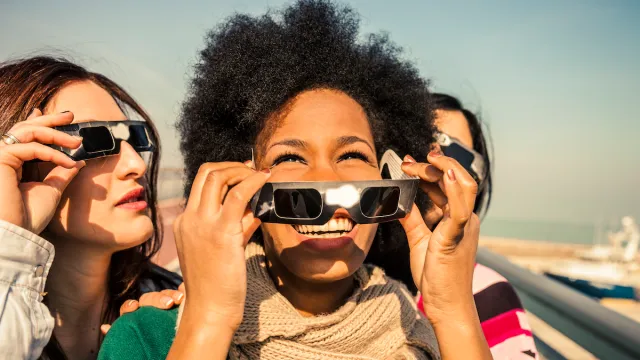Here’s Exactly When You Can Look Directly at the Solar Eclipse, NASA Says

For the first time since Aug. 2017, a total solar eclipse is set to take place on April 8, 2024—and it’ll be the last time one is visible from the U.S. for another 20 years. The extremely rare celestial event happens when the moon passes between the sun and the Earth, obstructing the sun’s radiance and emitting the moon’s cool shadow onto Earth. Those located within the path of totality will be able to see the outermost layer of the sun’s atmosphere, also called the corona, which is typically hidden by the sun’s brightness, according to the National Aeronautics and Space Administration (NASA).
The upcoming spectacle has prompted special travel plans, along with safety warnings about how looking directly at an eclipse can severely damage your eyes. However, a total solar eclipse is “the only type of solar eclipse where viewers can momentarily remove their eclipse glasses,” says NASA.
RELATED: 8 Best Destinations for the Next (and Rare) Total Solar Eclipse.
To start, eclipse viewers will need specialized eye protection, such as eclipse glasses or a safe handheld solar viewer, when glancing at the eclipse during its partial phases, per the government agency. These phases occur before and after totality.
Regular sunglasses, no matter how tinted they are, are not adequate for solar viewing. “Safe solar viewers are thousands of times darker and ought to comply with the ISO 12312-2 international standard,” NASA states on its safety viewing page.
“Viewing any part of the bright Sun through a camera lens, binoculars, or a telescope without a special-purpose solar filter secured over the front of the optics will instantly cause severe eye injury,” the organization explains.
Additionally, eclipse glasses and handheld viewers should always be carefully inspected for scratches or tears. If damaged, experts recommended tossing the viewing device and obtaining a new one.
Moreover, NASA says proper solar viewing devices should not be used in conjunction with a camera lens, telescope, or binoculars as “the concentrated solar rays will burn through the filter and cause serious eye injury.”
However, there will be a brief moment during the total solar eclipse when sungazers will be able to look directly at the celestial event with the naked eye.
“You can view the eclipse directly without proper eye protection only when the Moon completely obscures the Sun’s bright face—during the brief and spectacular period known as totality,” says NASA.
According to the agency, viewers will know the coast is clear when the sun is no longer visible through eclipse glasses or a solar viewer. But be sure to soak in the rare spectacle as much as possible because as soon as the sun starts to reappear, those protective shades must come back on.
RELATED: What Really Happens to Your Eyes If You Look Directly at a Solar Eclipse.
As you prepare for the grand celestial display, be mindful of faux or counterfeit eclipse glasses being sold by unvetted retailers.
Following the 2017 total solar eclipse, the American Astronomical Society (AAS) revealed that “the marketplace was flooded by counterfeit eclipse glasses that were labeled as ISO-compliant when in fact they had not been properly tested and shown to be safe.”
The AAS has since published a Suppliers of Safe Solar Filter & Viewers page with pre-vetted suppliers, so viewers can ensure they’re safe.